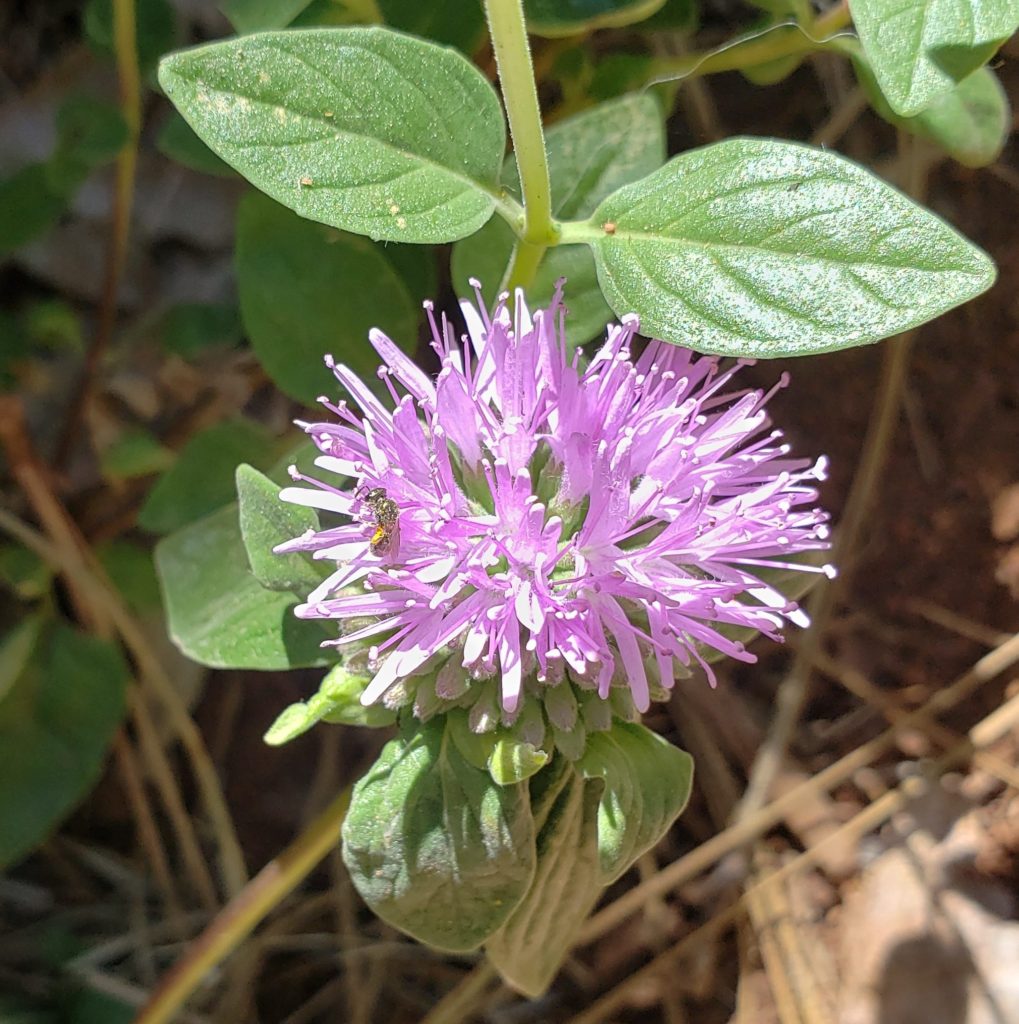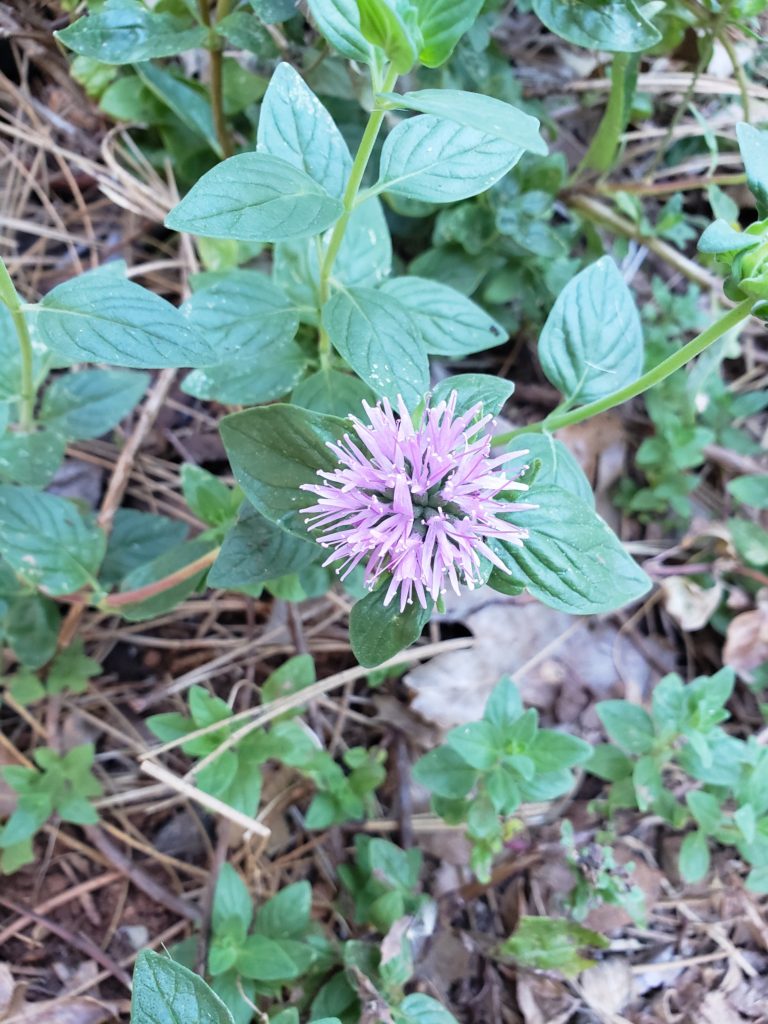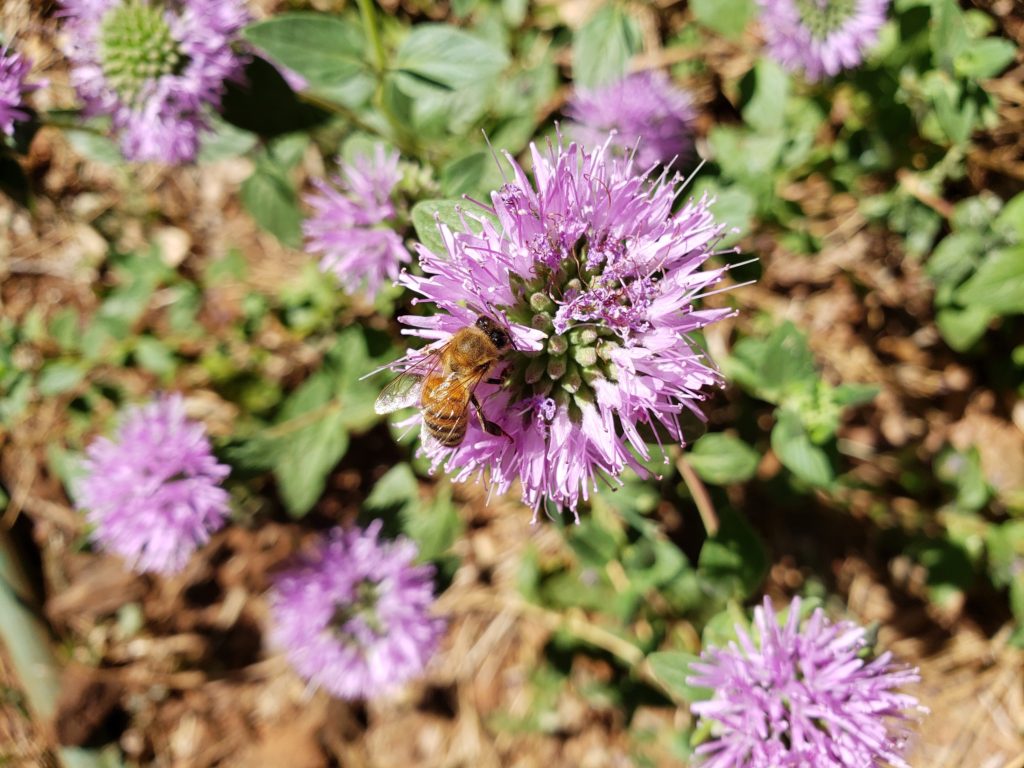Here’s a nice little native plant whose flowers attract butterflies and bees and it starts blooming in mid-summer. Coyote mint (Monardella villosa) is native to much of California, mostly in foothill areas north of Los Angeles up to southern Oregon and to the coastal ranges. (Though, somehow I don’t remember ever seeing it in the wild.) And it’s definitely native here. It’s nice to use in a drought tolerant garden.
It gets 1-2 ft. tall and up to 3 ft. wide and takes full sun (which is at least 6 hours of direct sun) to part shade. Plus, it has pretty flowers.

Flowers for bees and butterflies
The flowers are balls of pinkish-purple petals that attract butterflies and bees. To watch the butterflies, place the plants in a spot to get an up-close view.
You can even eat the flowers. You can use the petals either fresh or dried as a colorful garnish for salads. And you can use whole flower heads in a tea as described below.
Drought tolerant and deer resistant
Coyote mint likes to live in dry, gravelly soils, and on rocky slopes. But that doesn’t mean we can’t use it in our landscapes. It usually means we can put it in our driest situations.
It is drought tolerant, but it’s also summer semi-deciduous. This means its leaves can drop off when the plant gets too much heat and drought and new leaves will emerge when conditions are better. But to keep the plant looking better through the summer, a goal for our landscapes, we can water it…a little.
Calscape.org recommends irrigating up to 2 times per month, at most, through the hot season. And to be sure it has good drainage. If you don’t have good drainage, you can improve the soil structure before planting and consider even less water in the summer, perhaps only one or two deep soakings through the summer,
It spreads its stems out and roots fairly easily
Coyote mint is in the mint family but it has round stems unlike mint. It has fragrant, yet spicy foliage, like mint. And it spreads, but not vigorously and rambunctiously as mint does.
While a mint sends out stolons to expand itself all aver, coyote mint sends out semi-woody stems to get to its width, and some of those stems lay on the ground and root, increasing the spread of the plant.
This makes it easy for you to establish many plants. After rooting, the new baby plant can be cut from the mother plant, dug up, and replanted elsewhere.
I had purchased a plant and postponed planting it because I hadn’t decided on where to plant it. It’s just a little 4 inch pot. So I kept watering it in its pot through early summer. When I decided where to plant it I found that not only was it rooted in through the pot, but many of the stems were rooted, too. So I cut the stems from the mother plant and let them stay there. They’re actually in a great place that needed filling. And I’ll plant the mother plant in its new spot.
Some good spots for this plant
Since it likes dry conditions coyote mint is a good plant for rock gardens and dry herb gardens. Herbs from the Mediterranean like thyme, oregano, rosemary, sage, and lavender like dry conditions and coyote mint will fit right into a garden with these plants.
It can be used as a nice edging plant, a small, low shrub in native plantings, to line walkways, and at the edge of a rock wall where the plant can spill over and show off its flowers.
Some plants to plant with it
California poppies, groundcover manzanitas, and native grasses go nicely with it.. And by all means consider it a part of a planting of native shrubs and trees to create low water, deer resistant plantings in your landscape that feed native insects and birds.
Native means ecosystem support
Being a native plant often means that it supports insects that our birds rely on for food. Coyote mint hosts up to eight moths throughout California. According to Calscape.org, the only one that lives here is the California Pyrausta moth. This moth lives in slightly lower elevations than Grass Valley and Nevada City, but does live in Penn Valley and around North San Juan. (See the map at Calscape.org).

It’s not the most impressive looking moth but it does an important job. In its caterpillar stage it eats the leaves of the host plant and, while at it, often becomes bird food in the spring when the birds need rich protein sources to rear their young. This supports our bird population. This is important because it helps our biodiversity, which maintains nature’s checks and balances systems to prevent undue pest problems. For more information see my article on the subject on my website.
It is edible!
You can use the leaves and flower heads for a slightly bitter minty seasoning or tea. As a tea, it is written in plant guides that it should be steeped in cold water, not boiled. It’s been used as a treatment of stomach aches, though I haven’t used it and can’t vouch for that.
But the flowers can be used as a garnish fresh or dried.

